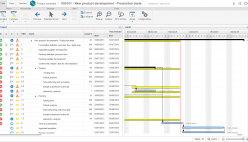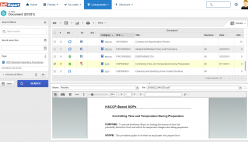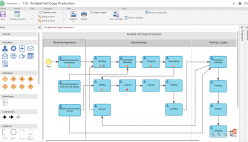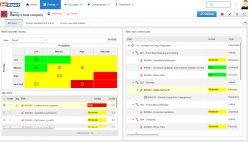ISO 22000
El Reto
Las organizaciones que producen, fabrican, manipulan o suministran alimentos reconocen la creciente exigencia de los clientes de que proporcionen pruebas adecuadas de su capacidad de identificar y controlar riesgos de seguridad alimentaria y las diversas variables que impactan en ella.
La norma ISO 22000 especifica los requisitos para el sistema de seguridad alimentaria en toda la cadena alimentaria, donde las organizaciones deben controlar riesgos de seguridad para proporcionar productos seguros que respondan tanto a los requisitos acordados con el cliente como a los reglamentos de seguridad alimentaria aplicables. La norma utiliza elementos clave para garantizar la seguridad alimentaria durante el proceso de producción, incluyendo la comunicación interactiva, la gestión del sistema, el control de los riesgos, el programa de prerrequisitos (PPRs) y el plan de APPCC.
ISO 22000 Solution
SoftExpert ofrece la solución de software más amplia y avanzada para la gestión de seguridad alimentaria, atendiendo las necesidades de los más rigurosos reglamentos globales. El Excellence Suite ayuda a las empresas a adherir a la norma ISO 22000, reduciendo los costos de conformidad, maximizando el éxito, aumentando la productividad y reduciendo los riesgos.
La solución de SoftExpert permite que las organizaciones atiendan los requisitos de la ISO 22000 de forma fácil, auxiliando en la gestión de riesgos, controles, planes de acción, descripción del producto, procesos de producción, no conformidades, indicadores de desempeño, entre otros, impulsando la eficiencia organizacional, reduciendo retrabajo y desperdicio. Con recursos de colaboración en línea, la organización y sus gestores pueden comunicar y ser actualizados sobre las iniciativas de conformidad, involucrando a más usuarios, equipos, oficinas y unidades de negocio a través de un abordaje sistemático y unificado para transformar directivas de calidad y seguridad en acciones.
Screenshots
Principales Beneficios
Organized and targeted communication among trade partners.
Optimización de recursos (internos y a lo largo de la cadena alimentaria).
Mejora de la documentación.
Mejor planificación y menos verificaciones posteriores al proceso.
Control más eficiente y dinámico de los riesgos de la seguridad alimentaria.
Todas las medidas de control se someten a un análisis de riesgos.
Gestión sistemática de los programas de prerrequisitos.
Ampliamente aplicable, pues está centrado en resultados finales.
Base válida para la toma de decisiones.
Control enfocado en lo que se necesita.
Economia de recursos reduciendo la superposición de las auditorías del sistema.
Garantia de la revisión del sistema de gestión de la seguridad alimentaria.
Revisión por la dirección optimizada del sistema de gestión de la inocuidad de los alimentos.



